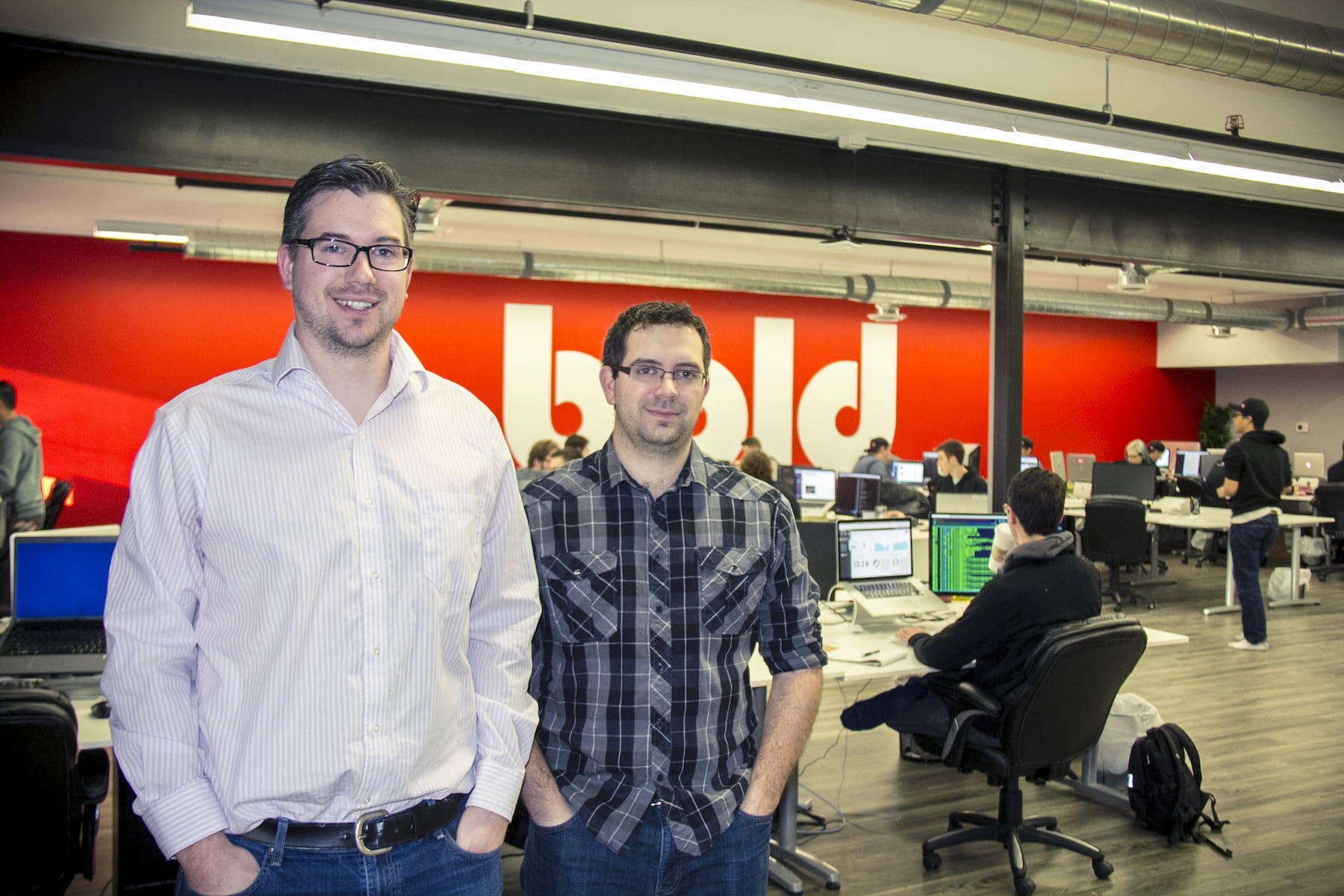Innovation motivation: App-building brothers find startup success as “code pirates”
“#InnovateOrDie,” reads the motto on the walls at Bold Innovation Group, and it’s a message the IT company takes to heart.
“We took an old motto and we renewed it for our generation,” explains Yvan Boisjoli (shown above, at left), one of Bold’s four founding partners. “[The original was], ‘If you’re not growing you’re dying.’ So what we did was just refresh it to #InnovateOrDie.”
Since Bold launched in March 2012, this mentality has helped the Île-des-Chênes-based company quickly become one of the leading third-party suppliers of apps for ecommerce behemoth Shopify.
Founded by brothers Yvan and Eric Boisjoli, Stefan Maynard and Jason Myers, Bold has already put 15 Shopify apps on the market and plans to launch another two per month for the foreseeable future. In its short time in existence, Bold has served almost 15,000 clients, including Microsoft, Time Life and Cirque du Soleil.
The Boisjoli brothers, both graduates of the Computer Analyst/Programmer (now called Business Information Technology) program at Red River College, are self-described ‘Code Pirates’ – meaning they build the apps – while Maynard is a ‘Design Ninja’ and Myers heads up Marketing. The fun job titles go hand-in-hand with the company’s ‘Work hard, play hard’ mentality; their office includes a foosball table and arcade games and the founders endeavor to ensure it’s a workplace with lots of perks.
The ‘Work hard’ part is also vitally important, as demonstrated by the company’s growth and success. Starting with just the four co-founders in 2012, Bold now has a staff of over 40. And they’re receiving accolades, winning the Young Enterprise category of the Entrepreneur Prizes handed out by the St. Boniface Chamber of Commerce, along with a national award for economic development and employability from Réseau de dévelopment économique et d’émployabilité (RDEE) Canada, the nation’s Francophone economic and employability network.
The idea to develop third-party apps for Shopify was conceived by Myers who at the time was running a few ecommerce websites and saw opportunities in the Shopify marketplace.
The foursome decided to start with the Product Upsell app, which allows ecommerce retailers to quickly and easily upsell or clear out inventory at the checkout based on items the customer has in their cart. For example, if you were buying a camera online, at checkout you’d be asked if you want to purchase batteries. To date it’s the company’s most downloaded app.
“I think it was Yvan who chose Upsell because he thought at the time it would probably be one of the easiest apps to build…,” says Eric, 29 (shown above, at right).
“…Turned out to be the hardest one,” laughs Yvan, 32. “I think we’re done developing it now, but we’ve probably been developing it for a year and a half. We’ve released 15 apps and [with] the other ones, after a few months, we’re done.”
One of the apps they plan to launch in the coming weeks is the Marketplace App, which turns your online store into a third party retailer, kind of like Amazon.
The brothers believe part of Bold’s success lies in having four founders working together, which helped set them apart in the Shopify marketplace.
“There were [other] developers that were building apps that didn’t have anybody wanting to support the apps. So customers weren’t giving them positive feedback because they weren’t getting the support they deserved. Whereas we had a guy dedicated to supporting our customers,” Eric says.
Developing innovative apps for Shopify is just one of the ways Bold’s team members ensure they’re on the cutting edge of technology. A full 20 per cent of the company’s resources are dedicated to developing products that aren’t related to their core business.
“That’s part of our whole innovation mentality,” Eric says. “We’re happy doing stuff for Shopify and we’re going to continue putting most of our efforts on that, but we also want to grow in other ways. We have Picticipate and a whole Bold Labs department dedicated to new projects and new ideas. They all dress up like scientists,” he adds with a laugh.
Picticipate, a photo sharing software, had a “very soft launch” a few months ago. The team is currently rejigging it and expects to relaunch in mid-December.
Another example of the company’s penchant for innovation is their Hack Days.
“Every six months we take two days were you drop everything that you’re doing and you just build something that you’ve always wanted to do that’s just not your everyday work,” Yvan explains.
As successful as Bold is, all four founders have plenty of experience with startups that haven’t done so well. They’ve learned to make each failure a learning experience.
“We know that 90 per cent of startups don’t make it, so if you keep trying and launch enough of them, one is bound to be part of that 10 per cent,” Eric says. “You just shrug it off, you keep trying and luckily we hit it off with Bold and now we keep on trying new ideas so hopefully one of those takes off as well.”
For the brothers, studying at RRC was an easy choice because both loved the hands-on nature of the program.
“I went to university for two years not knowing what I wanted to do… Just listening to theory I was kind of annoyed with university,” Yvan says. “[At RRC] I was able to actually practice coding… and that caught my attention a lot more. I was able to concentrate a lot more in class because I was actually doing it, instead of listening to somebody talk about it.”
They also appreciated the program’s local applicability.
“I liked how the course was actually driven by industry in Winnipeg,” Eric says. “So people in Winnipeg actually say ‘This is important for a programmer in Winnipeg to know,’ and we were given courses based on that. As opposed to at university, where it’s ‘Here’s 100 options; choose whatever you want, but it might not apply in the future.”
Click here for more info about Bold Innovation Group and here for more info about the Business Information Technology program at Red River College.
Profile by Stacy Cardigan Smith (Creative Communications, 2006)

